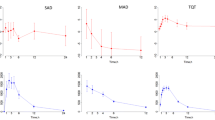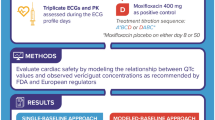Abstract
The effects of contezolid (MRX-I, an oxazolidinone antibacterial agent) on cardiac repolarization were evaluated retrospectively using a population modeling approach in a Phase I study incorporating single ascending dose, multiple ascending dose, and food effect assessments. Linear mixed effect models were used to assess the relationships between MRX-I plasma concentrations and QT/QTc/∆QTc (baseline-adjusted), in which different correction methods for heart rate have been included. The upper bound of the one-sided 95% confidence interval (CI) for predicted ∆∆QTc was < 10 ms (ms) at therapeutic doses of MRX-I. Model performance/suitability was determined using diagnostic evaluations, which indicated rationality of one-stage concentration-QT model, as well as C-QT model suggested by Garnett et al. The finding demonstrated that MRX-I may have no clinical effects on the QT interval. Concentration-QT model may be an alternative to conventional thorough QT studies.






Similar content being viewed by others
References
Wu X, Li Y, Zhang J, Zhang Y, Yu J, Cao G, Chen Y, Guo B, Shi Y, Huang J, Cao Y, Liu X, Wu J, Gordeev MF, Yuan H, Wang W (2018) Short-term safety, tolerability, and pharmacokinetics of MRX-I, an oxazolidinone antibacterial agent, in healthy Chinese subjects. Clin Ther 40(2):322–332.e325. https://doi.org/10.1016/j.clinthera.2017.12.017
Gordeev MF, Yuan ZY (2014) New potent antibacterial oxazolidinone (MRX-I) with an improved class safety profile. J Med Chem 57(11):4487–4497. https://doi.org/10.1021/jm401931e
Shoen C, DeStefano M, Hafkin B, Cynamon M (2018) In vitro and in vivo activity of contezolid (MRX-I) against Mycobacterium tuberculosis. Antimicrob Agents Chemother. https://doi.org/10.1128/aac.00493-18
Damle B, Labadie RR, Cuozzo C, Alvey C, Choo HW, Riley S, Kirby D (2011) Lack of an effect of standard and supratherapeutic doses of linezolid on QTc interval prolongation. Antimicrob Agents Chemother 55(9):4302–4307. https://doi.org/10.1128/aac.01723-10
ICH Guideline E14 (2005) The clinical evaluation of QT/QTc interval prolongation and proarrhythmic potential for non-antiarrhythmic drugs. http://www.ich.org/fileadmin/Public_Web_Site/ICH_Products/Guidelines/Efficacy/E14/E14_Guideline.pdf
Lester RM, Paglialunga S, Johnson IA (2019) QT Assessment in early drug development: the long and the short of it. Int J Mol Sci 20(6):1324. https://doi.org/10.3390/ijms20061324
ICH E14 Questions & Answers (R3) (2015) The clinical evaluation of QT/QTc interval prolongation and proarrhythmic potential for non-antiarrhythmic drugs—questions and answers (R3). http://www.ich.org/fileadmin/Public_Web_Site/ICH_Products/Guidelines/Efficacy/E14/E14_Q_As_R3__Step4.pdf
Garnett CE, Beasley N, Bhattaram VA, Jadhav PR, Madabushi R, Stockbridge N, Tornoe CW, Wang Y, Zhu H, Gobburu JV (2008) Concentration-QT relationships play a key role in the evaluation of proarrhythmic risk during regulatory review. J Clin Pharmacol 48(1):13–18. https://doi.org/10.1177/0091270007307881
Xu FY, Huang JH, He YC, Liang LY, Li LJ, Yang J, Yin F, Xu L, Zheng QS, Wang K (2017) Population pharmacokinetics of moxifloxacin and its concentration-QT interval relationship modeling in Chinese healthy volunteers. Acta Pharmacol Sin 38(11):1580–1588. https://doi.org/10.1038/aps.2017.76
Garnett C, Bonate PL, Dang Q, Ferber G, Huang D, Liu J, Mehrotra D, Riley S, Sager P, Tornoe C, Wang Y (2017) Scientific white paper on concentration-QTc modeling. J Pharmacokinet Pharmacodyn. https://doi.org/10.1007/s10928-017-9558-5
Sheiner LB, Beal SL (1981) Some suggestions for measuring predictive performance. J Pharmacokinet Biopharm 9(4):503–512
Rudd GD, Sake JK (2011) Lamotrigine does not prolong QTc in a thorough QT/QTc study in healthy subjects, Dixon et al. 2008; request for publication of PR interval data. Br J Clin Pharmacol 71(6):963. https://doi.org/10.1111/j.1365-2125.2010.03856.x
Nelson CH, Wang L, Fang L, Weng W, Cheng F, Hepner M, Lin J, Garnett C, Ramanathan S (2015) A quantitative framework to evaluate proarrhythmic risk in a first-in-human study to support waiver of a thorough QT study. Clin Pharmacol Ther 98(6):630–638. https://doi.org/10.1002/cpt.204
Darpo B, Benson C, Dota C, Ferber G, Garnett C, Green CL, Jarugula V, Johannesen L, Keirns J, Krudys K, Liu J, Ortemann-Renon C, Riley S, Sarapa N, Smith B, Stoltz RR, Zhou M, Stockbridge N (2015) Results from the IQ-CSRC prospective study support replacement of the thorough QT study by QT assessment in the early clinical phase. Clin Pharmacol Ther 97(4):326–335. https://doi.org/10.1002/cpt.60
Trinkley KE, Page RL II, Lien H, Yamanouye K, Tisdale JE (2013) QT interval prolongation and the risk of torsades de pointes: essentials for clinicians. Curr Med Res Opin 29(12):1719–1726. https://doi.org/10.1185/03007995.2013.840568
Piotrovsky V (2005) Pharmacokinetic-pharmacodynamic modeling in the data analysis and interpretation of drug-induced QT/QTc prolongation. AAPS J 7(3):E609–E624. https://doi.org/10.1208/aapsj070363
Acknowledgements
The author thanked the sponsor of the study, MicuRx Pharmaceuticals, Inc.
Funding
This study was financially supported by the Major Research and Development Project of Innovative Drugs, Ministry of Science and Technology of China (2017ZX09304005).
Author information
Authors and Affiliations
Corresponding author
Ethics declarations
Conflicting of interest
The authors declare no conflicts of interest.
Additional information
Publisher's Note
Springer Nature remains neutral with regard to jurisdictional claims in published maps and institutional affiliations.
Electronic supplementary material
Below is the link to the electronic supplementary material.
Rights and permissions
About this article
Cite this article
Wu, J., Wang, K., Chen, Y. et al. Concentration–response modeling of ECG data from early-phase clinical studies to assess QT prolongation risk of contezolid (MRX-I), an oxazolidinone antibacterial agent. J Pharmacokinet Pharmacodyn 46, 531–541 (2019). https://doi.org/10.1007/s10928-019-09650-7
Received:
Accepted:
Published:
Issue Date:
DOI: https://doi.org/10.1007/s10928-019-09650-7




